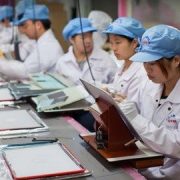By now, we have all become experts in offshoring, the practice whereby American companies relocate manufacturing jobs overseas to take advantage of low wages, missing unions, the lack of regulation, and the paucity of environmental controls. The strategy has been by far the largest source of new profits enjoyed by big companies for the past two decades. It has also been blamed for losses of US jobs, with some estimates reaching as high as 25 million.
When offshoring first started 50 years ago, it was a total no-brainer. Wages were sometimes 95% cheaper than those at home. The cost savings were so great that you could amortize your total capital costs in as little as two years. So American electronics makers began filing overseas to Singapore, Thailand, Hong Kong, Taiwan, South Korea, and the Philippines. After the US normalized relations with China 50 years ago, the action moved there and found that labor was even cheaper.
Then, a funny thing happens. After 40 years of falling real American wages and soaring Chinese wages, offshoring isn’t such a great deal anymore. The average Chinese laborer earned $100 a year in 1977. Today, it is $6,563, and $24,000 for trained technicians, with total compensation rising 20% a year. At this rate, US and Chinese wages will reach parity in about 10 years.
But wages won’t have to reach parity for onshoring to accelerate in a meaningful way. Investing in China is still not without risks. Managing a global supply chain is no piece of cake on a good day. Asian countries still lack much of the infrastructure that we take for granted here. Natural disasters like earthquakes, fires, and tidal waves can have a hugely disruptive impact on a manufacturing system that is in effect a highly tuned, incredibly complex watch.
There are also far larger political risks in keeping a large chunk of our manufacturing base in the Middle Kingdom than most Americans realize. With the US fleet and the Chinese military playing an endless game of chicken off the Tawan coast, we are one mid-air collision away from a major diplomatic incident. Protectionism constantly threatens to boil over in the US, whether it is over the dumping of chicken feet, tires, or the latest, solar cells.
This is what the visits to the Foxconn factory by Apple’s CEO, Tim Cook, are all about. Be nice to the workers there, let them work only 8 hours a day instead of 16, let them unionize, and guess what? Work will come back to the US all the faster. This week, the Chinese press was ripe with speculation that Apple-induced reforms might spread to the rest of the country like wildfire.
The impact of a real onshoring move on the US economy would be huge. Some economists estimate that as many as 10%-30% of the jobs lost to offshoring could return. At the high end, this could amount to 8 million jobs. That would cut our unemployment rate down by half, at least. It added $20-$60 billion in GDP per year, or up to 0.4% in economic growth per year. It would also lead to a much stronger dollar, rising stocks, and lower bond prices. Is this what the stock market is trying to tell us, rising by 34% off the October lows?
Who would be the biggest beneficiaries of an onshoring trend? Si! Ole! Mexico, which took the biggest hit when China started soaking up all the low-wage jobs in the world. After that, the industrial Midwest has to figure pretty large, especially in gutted Michigan. With real estate prices there below their 1992 lows, if there is a market at all, you know that doing business there costs a fraction of what it did 20 years ago.
I Hear They're Offering $2 an Hour Across the Street




